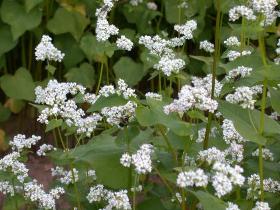Buckwheat, forgotten but still useful ingredient

Swiss researchers have evaluated buckwheat as an alternative feed for ruminants. Buckwheat proved to be a plant that offers different feeds of a quality sufficient to be considered suitable in ruminant nutrition.
Buckwheat is of high value in crop rotations and overall agricultural ecology because of strong rooting and intensive flowering properties, but it is rarely cultivated and information on its nutritional value to ruminants is scarce.
The contents of net energy for lactation (NEL), as estimated with the Hohenheim Gas Test (n = 3), were 4.3, 4.9 and 7.5 MJ NEL/kg dry matter (DM) for fresh and ensiled whole buckwheat plants and buckwheat grain, respectively.
In two experiments with the Rumen Simulation Technique (Rusitec), ruminal fermentation characteristics of buckwheat forages and buckwheat grain were evaluated.
Replacing hay
In the first experiment, 0, 300 or 600 g/kg of a pure hay diet were replaced by either fresh or ensiled buckwheat to create five diets.
Neither form of buckwheat forages had effects on in vitro ruminal degradability and short chain fatty acid (SCFA) concentrations and composition.
The use of fresh buckwheat reduced ruminal ammonia concentrations and enhanced estimated microbial N growth efficiency.
Ensiling changes nutritional value
These differences did not occur with silage, indicating a change in nutritional value by ensiling.
Fresh buckwheat reduced the number of bacteria in the incubated fluid, while ensiled buckwheat reduced that of holotrich protozoa. Methane formation was not influenced by the buckwheat forages.
Replacing wheat meal
In the second experiment, wheat meal (400 g/kg dietary DM), was replaced stepwise (0.5 and 1.0) by buckwheat grain meal.
This did not cause differences in parameters of nutrient degradability, relative N efficiency and total amount and composition of SCFA.
Holotrich protozoa counts increased, but total gas formation decreased with increasing dietary level of buckwheat grain.
Animal performance
In a final experiment, cows yielding about 40 kg milk/day were fed mixed silage-concentrate diets.
A control diet contained no buckwheat. In a second diet, maize silage was partly substituted by buckwheat silage (98 g/kg dietary DM). In a third group, part of the energy concentrate was substituted by buckwheat grain meal (94 g/kg).
There were no effects on feed intake, milk yield and milk composition. Buckwheat proved to be a plant that offers different feeds of a quality sufficient to be considered suitable in ruminant nutrition.
S.L. Amelchankaa, M. Kreuzera, and F. Leiber, ETH Zurich, Department of Agricultural and Food Sciences, Zurich, Switzerland.: “Utility of buckwheat (Fagopyrum esculentum Moench) as feed: Effects of forage and grain on in vitro ruminal fermentation and performance of dairy cows” Obtain the full report.











